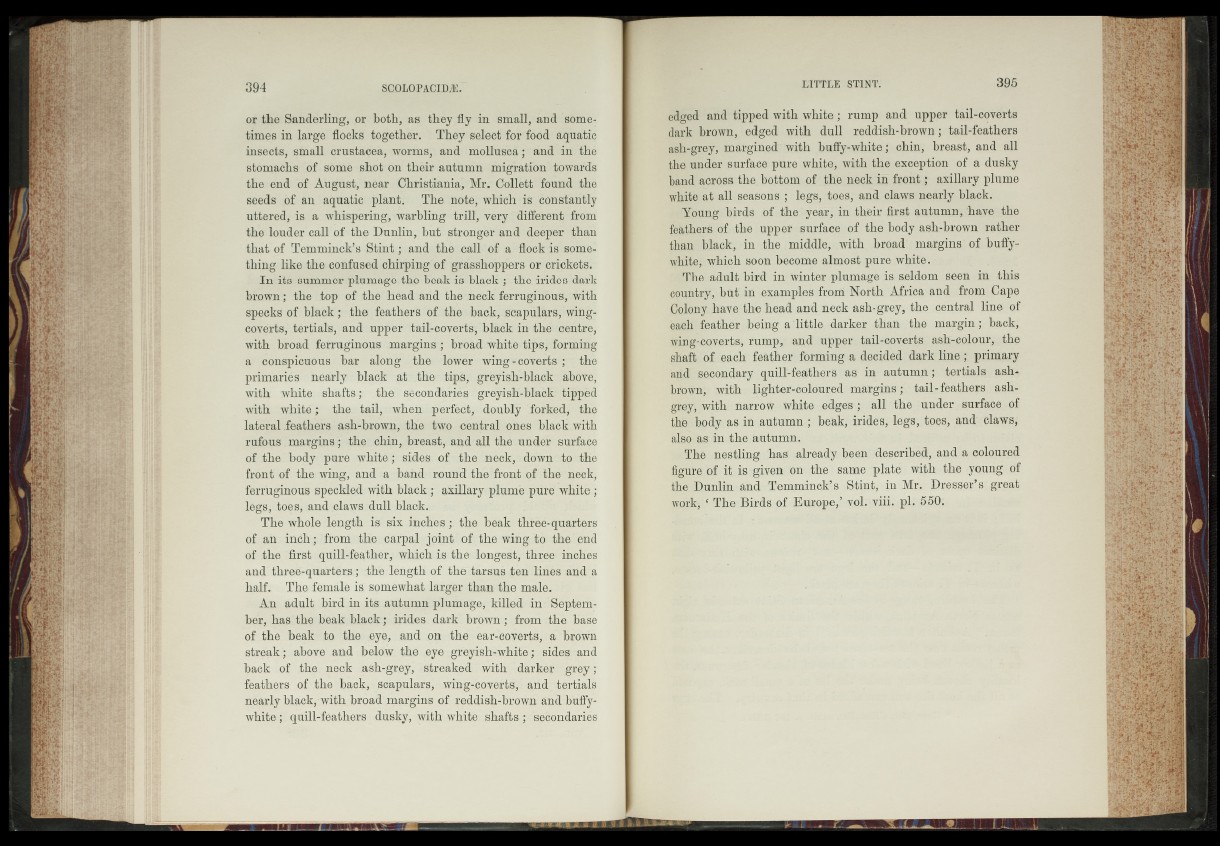
or the Sandérlirig, or both, as théy fly in small, and sometimes
in large flocks together. They select for food aquatic
insects, small Crustacea, worms, and mollusca; and in the
stomachs of some shot on théir autumn migration towards
the end of August, near Christiania, Mr. Gollètt found the
seeds óf an aquatic plant. The note, which is constantly
uttered, is. a whispering, warbling trill, very$ different from
the louder call of the Dunlin, but stronger and deeper than
that of Temminck’s Stint; and .thé call" of a flock is something
like the confused chirping of grasshoppers or criekets.'
In its summer jplumagè the beak is black ; the irides daik
brown ; the top of the head arid the heck ferruginous, with
specks of black; the feathers of the back, scapulars, wing;
coverts,r tertials, and upper 'daih-eoverts;'black in the ^centre,
with broad ferruginous marginsbroad whitë” tips! forruing
a conspicuous bar along-the lower wing - coverts- r " the
primaries nearly ; black at* the-tips, greyish-black :above,
with white, shafts; the secondaries greyish-black1 tipped
with whiter the. tail, :whemi«porféct, doubly '.forked,' the
lateral .feathers ash-brown, the two central ones ihlack^wth
rufous margins '; the chin, breast-,- andcall thé.under -surface
of the' body pure white; sides of*? the neck;; down tq&jfcKe
front of thri;wing, and a band- i round thelfront -ofothè' neck,
ferruginous speckled with black.; axillary -pluto'e- pure’ white';
legs, toes, and elaws dull black.
The whole 'length- is six inches;-the beak three-quarters
of an I in^hi; ifrom the carpal -joint' of/the.-w-arigr'tó1 the',énd
of the first quill-feqtbër, whichvisïBiéï longest:,*:fïr^f4hóhes
and three-quarters; the length', of the“t |f sus ten liriès -and a
half. iThe female is/spn^ewhat larger than the male. -'
a An adult bird in.its^utumn plu-nia^e," killed- Ind'Septem-
ber, hasithe beak black; irides darkl brown.; from the base
of the beak to the ey§;, and on the ear-coverts, a brown
streak; above and below the .#ye; greyish-white-;; sides:-and
hack of .the neck ash-grey, streaked | with darkerji-grey;
feathers of the back,- .scapulars,’ wing-covèrts,: and tertials
nearly hlaekj with broad margins of .reddish-fete» and buffy-
wbite; quill-featfeès.^ dusky, with.^white shafts Secondaries
edged and tipped with white; rump and upper tail-coverts
dark brown, edged with dull reddish-brown; tail-feathers
ash-grey, inargiried' with huffy-white; chin, breast, and all
the under surface pure white, with the exception of a dusky
band across the, bottom of the neck in front; axillary plume
white at all seasons ; legs, toes, and claws nearly black.
Young birds of - ibbJye&r; in their first autumn, 'have" the
feathers of tthe upper- -surface of the body ash-brown rather
than -black, in the ;middle;-,with, ;br©ad'j margins' of buffy-
wbjtej' which soon become almost, pure white. - -
The adult bird in winter plumage is -seldom seen in this
country, but' in examples from N'ofth Africa and from Cape
Colony have!the head an d n e ck ash-grey,- Ifes -central line' of
each feather.being a'litf|%;darke£ than .'the margin; back,
wing-^overts, rump,- and upper t ail-coverts, asb>oplour,..the
shaft !@f; each feather forming a decided- dark line ; primary
andt secondary quill-feathers' as in autumn ; tertials ash-
brown, with lighteiPcoloured margins ; ; tail-feathers, ash-
grey, fw?ith narrow fvhi-te -tedgess*-; all;:the u n d e r. surface of
th ^ bqdy as in autumn ; beak, irides, legs;-toes, and claws;
also as iriuthe autumns' ■
The nestling Jhas" .already been' described, and .-a^pjhured
figure bf it is given on-the same plate: with- the young off
the Dunlin and -Temminck^&Stint, in ^lr,. Dresser’s great
‘WCi’k-f £’The Birds of Europe,’ vQ^viii.^pl;* J550: